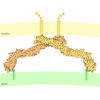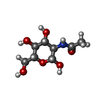+ Open data
Open data
- Basic information
Basic information
| Entry | Database: PDB / ID: 9gh5 | ||||||||||||||||||||||||||||||
|---|---|---|---|---|---|---|---|---|---|---|---|---|---|---|---|---|---|---|---|---|---|---|---|---|---|---|---|---|---|---|---|
| Title | Complex of Fusobacterium nucleatum CbpF with human CEACAM1 | ||||||||||||||||||||||||||||||
 Components Components |
| ||||||||||||||||||||||||||||||
 Keywords Keywords | CELL ADHESION / bacterial pathogenesis / adhesin / immunomodulation / host-pathogen interaction | ||||||||||||||||||||||||||||||
| Function / homology |  Function and homology information Function and homology informationregulation of endothelial cell differentiation / insulin receptor internalization / negative regulation of cytotoxic T cell degranulation / granulocyte colony-stimulating factor signaling pathway / regulation of homophilic cell adhesion / negative regulation of hepatocyte proliferation / Regulation of MITF-M dependent genes involved in invasion / filamin binding / regulation of epidermal growth factor receptor signaling pathway / regulation of blood vessel remodeling ...regulation of endothelial cell differentiation / insulin receptor internalization / negative regulation of cytotoxic T cell degranulation / granulocyte colony-stimulating factor signaling pathway / regulation of homophilic cell adhesion / negative regulation of hepatocyte proliferation / Regulation of MITF-M dependent genes involved in invasion / filamin binding / regulation of epidermal growth factor receptor signaling pathway / regulation of blood vessel remodeling / regulation of sprouting angiogenesis / negative regulation of natural killer cell mediated cytotoxicity directed against tumor cell target / negative regulation of lipid biosynthetic process / negative regulation of T cell mediated cytotoxicity / regulation of endothelial cell migration / negative regulation of granulocyte differentiation / insulin catabolic process / regulation of phosphatidylinositol 3-kinase/protein kinase B signal transduction / Fibronectin matrix formation / common myeloid progenitor cell proliferation / : / negative regulation of interleukin-1 production / positive regulation of vasculogenesis / negative regulation of fatty acid biosynthetic process / negative regulation of platelet aggregation / bile acid transmembrane transporter activity / negative regulation of vascular permeability / regulation of immune system process / wound healing, spreading of cells / negative regulation of T cell receptor signaling pathway / transport vesicle membrane / bile acid and bile salt transport / blood vessel development / microvillus membrane / homophilic cell-cell adhesion / tertiary granule membrane / lateral plasma membrane / regulation of ERK1 and ERK2 cascade / negative regulation of protein kinase activity / specific granule membrane / regulation of cell migration / protein tyrosine kinase binding / basal plasma membrane / integrin-mediated signaling pathway / Cell surface interactions at the vascular wall / adherens junction / regulation of cell growth / cell outer membrane / kinase binding / cellular response to insulin stimulus / cell-cell junction / cell junction / cell migration / protein transport / actin binding / angiogenesis / protein phosphatase binding / calmodulin binding / cell adhesion / protein dimerization activity / apical plasma membrane / Neutrophil degranulation / cell surface / signal transduction / protein homodimerization activity / extracellular exosome / identical protein binding / membrane / plasma membrane Similarity search - Function | ||||||||||||||||||||||||||||||
| Biological species |  Fusobacterium nucleatum (bacteria) Fusobacterium nucleatum (bacteria) Homo sapiens (human) Homo sapiens (human) | ||||||||||||||||||||||||||||||
| Method | ELECTRON MICROSCOPY / single particle reconstruction / cryo EM / Resolution: 2.7 Å | ||||||||||||||||||||||||||||||
 Authors Authors | Marongiu, G.L. / Fink, U. / Roderer, D. | ||||||||||||||||||||||||||||||
| Funding support |  Germany, 1items Germany, 1items
| ||||||||||||||||||||||||||||||
 Citation Citation |  Journal: Proc Natl Acad Sci U S A / Year: 2025 Journal: Proc Natl Acad Sci U S A / Year: 2025Title: Structural basis for immune cell binding of via the trimeric autotransporter adhesin CbpF. Authors: Gian Luca Marongiu / Uwe Fink / Felix Schöpf / Andreas Oder / Jens Peter von Kries / Daniel Roderer /  Abstract: (Fn), a commensal in the human oral cavity, is overrepresented in the colon microbiota of colorectal cancer (CRC) patients and is linked to tumor chemoresistance, metastasis, and a poor therapeutic ... (Fn), a commensal in the human oral cavity, is overrepresented in the colon microbiota of colorectal cancer (CRC) patients and is linked to tumor chemoresistance, metastasis, and a poor therapeutic prognosis. Fn produces numerous adhesins that mediate tumor colonization and downregulation of the host's antitumor immune response. One of these, the trimeric autotransporter adhesin (TAA) CEACAM binding protein of (CbpF), targets CEACAM1 on T-cells and has been associated with immune evasion of Fn-colonized tumors. Whereas the role of CEACAM1 in homophilic and heterophilic cell interactions and immune evasion is well described, the mechanistic details of its interaction with fusobacterial CbpF remain unknown due to the lack of a high-resolution structure of the adhesin-receptor complex. Here, we present two structures of CbpF alone and in complex with CEACAM1, obtained by cryogenic electron microscopy and single particle analysis. They reveal that CbpF forms a stable homotrimeric complex whose N-terminal part of the extracellular domain comprises a 64 Å long β roll domain with a unique lateral loop extension. CEACAM1 binds to this loop with high affinity via its N-terminal IgV-like domain with a nanomolar dissociation constant as determined by surface plasmon resonance. This study provides a comprehensive structural description of a fusobacterial TAA, illustrates a yet undescribed CEACAM1 binding mode, and paves the way for rational drug design targeting Fn in CRC. | ||||||||||||||||||||||||||||||
| History |
|
- Structure visualization
Structure visualization
| Structure viewer | Molecule:  Molmil Molmil Jmol/JSmol Jmol/JSmol |
|---|
- Downloads & links
Downloads & links
- Download
Download
| PDBx/mmCIF format |  9gh5.cif.gz 9gh5.cif.gz | 286.2 KB | Display |  PDBx/mmCIF format PDBx/mmCIF format |
|---|---|---|---|---|
| PDB format |  pdb9gh5.ent.gz pdb9gh5.ent.gz | 219.4 KB | Display |  PDB format PDB format |
| PDBx/mmJSON format |  9gh5.json.gz 9gh5.json.gz | Tree view |  PDBx/mmJSON format PDBx/mmJSON format | |
| Others |  Other downloads Other downloads |
-Validation report
| Summary document |  9gh5_validation.pdf.gz 9gh5_validation.pdf.gz | 1 MB | Display |  wwPDB validaton report wwPDB validaton report |
|---|---|---|---|---|
| Full document |  9gh5_full_validation.pdf.gz 9gh5_full_validation.pdf.gz | 1.1 MB | Display | |
| Data in XML |  9gh5_validation.xml.gz 9gh5_validation.xml.gz | 58.2 KB | Display | |
| Data in CIF |  9gh5_validation.cif.gz 9gh5_validation.cif.gz | 84.5 KB | Display | |
| Arichive directory |  https://data.pdbj.org/pub/pdb/validation_reports/gh/9gh5 https://data.pdbj.org/pub/pdb/validation_reports/gh/9gh5 ftp://data.pdbj.org/pub/pdb/validation_reports/gh/9gh5 ftp://data.pdbj.org/pub/pdb/validation_reports/gh/9gh5 | HTTPS FTP |
-Related structure data
| Related structure data |  51347MC  9gh4C  9gh6C C: citing same article ( M: map data used to model this data |
|---|---|
| Similar structure data | Similarity search - Function & homology  F&H Search F&H Search |
- Links
Links
- Assembly
Assembly
| Deposited unit | 
|
|---|---|
| 1 |
|
- Components
Components
| #1: Protein | Mass: 51827.051 Da / Num. of mol.: 3 Source method: isolated from a genetically manipulated source Details: full length protein, residues 25-274 are resolved / Source: (gene. exp.)  Fusobacterium nucleatum (bacteria) / Gene: FN1499 / Production host: Fusobacterium nucleatum (bacteria) / Gene: FN1499 / Production host:  #2: Protein | Mass: 44153.664 Da / Num. of mol.: 3 Source method: isolated from a genetically manipulated source Details: CEACAM1 extracellular domain with C-terminal histag (Acro Biosystems) Source: (gene. exp.)  Homo sapiens (human) / Gene: CEACAM1, BGP, BGP1 / Production host: Homo sapiens (human) / Gene: CEACAM1, BGP, BGP1 / Production host:  Homo sapiens (human) / References: UniProt: P13688 Homo sapiens (human) / References: UniProt: P13688#3: Sugar | ChemComp-NAG / #4: Water | ChemComp-HOH / | Has ligand of interest | N | Has protein modification | Y | |
|---|
-Experimental details
-Experiment
| Experiment | Method: ELECTRON MICROSCOPY |
|---|---|
| EM experiment | Aggregation state: PARTICLE / 3D reconstruction method: single particle reconstruction |
- Sample preparation
Sample preparation
| Component | Name: Hetero-hexameric complex of CbpF homotrimer with 3 CEACAM1 bound Type: COMPLEX / Entity ID: #1-#2 / Source: RECOMBINANT |
|---|---|
| Molecular weight | Value: 0.35 MDa / Experimental value: NO |
| Source (natural) | Organism:  Fusobacterium nucleatum (bacteria) Fusobacterium nucleatum (bacteria) |
| Source (recombinant) | Organism:  |
| Buffer solution | pH: 7 |
| Specimen | Embedding applied: NO / Shadowing applied: NO / Staining applied: NO / Vitrification applied: YES |
| Specimen support | Grid material: COPPER / Grid mesh size: 300 divisions/in. / Grid type: Quantifoil R1.2/1.3 |
| Vitrification | Cryogen name: ETHANE |
- Electron microscopy imaging
Electron microscopy imaging
| Experimental equipment |  Model: Titan Krios / Image courtesy: FEI Company |
|---|---|
| Microscopy | Model: FEI TITAN KRIOS |
| Electron gun | Electron source:  FIELD EMISSION GUN / Accelerating voltage: 300 kV / Illumination mode: FLOOD BEAM FIELD EMISSION GUN / Accelerating voltage: 300 kV / Illumination mode: FLOOD BEAM |
| Electron lens | Mode: BRIGHT FIELD / Nominal magnification: 105000 X / Nominal defocus max: 2400 nm / Nominal defocus min: 1200 nm / Alignment procedure: ZEMLIN TABLEAU |
| Specimen holder | Cryogen: NITROGEN / Specimen holder model: FEI TITAN KRIOS AUTOGRID HOLDER |
| Image recording | Electron dose: 52.8 e/Å2 / Film or detector model: GATAN K3 BIOQUANTUM (6k x 4k) / Num. of grids imaged: 1 / Num. of real images: 6334 |
| EM imaging optics | Energyfilter name: GIF Bioquantum / Energyfilter slit width: 20 eV |
- Processing
Processing
| EM software |
| ||||||||||||||||||||||||||||||||||||||||
|---|---|---|---|---|---|---|---|---|---|---|---|---|---|---|---|---|---|---|---|---|---|---|---|---|---|---|---|---|---|---|---|---|---|---|---|---|---|---|---|---|---|
| CTF correction | Type: PHASE FLIPPING AND AMPLITUDE CORRECTION | ||||||||||||||||||||||||||||||||||||||||
| Particle selection | Num. of particles selected: 1766853 | ||||||||||||||||||||||||||||||||||||||||
| Symmetry | Point symmetry: C3 (3 fold cyclic) | ||||||||||||||||||||||||||||||||||||||||
| 3D reconstruction | Resolution: 2.7 Å / Resolution method: FSC 0.143 CUT-OFF / Num. of particles: 211927 / Num. of class averages: 1 / Symmetry type: POINT | ||||||||||||||||||||||||||||||||||||||||
| Atomic model building | Protocol: FLEXIBLE FIT / Space: REAL | ||||||||||||||||||||||||||||||||||||||||
| Refine LS restraints |
|
 Movie
Movie Controller
Controller





 PDBj
PDBj








